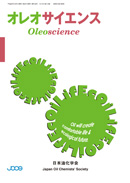All issues

Volume 13, Issue 3
Displaying 1-3 of 3 articles from this issue
- |<
- <
- 1
- >
- >|
-
Yasuhiro SAKAI, Kohzo ITO2013Volume 13Issue 3 Pages 111-116
Published: 2013
Released on J-STAGE: February 01, 2016
JOURNAL FREE ACCESSSupramolecular-structured polymeric materials, whose properties are designed and controlled by topological constraint have attracted growing interest recently. Polyrotaxane (PR), in which cyclic molecules are threaded into a linear polymer chain, is a typical example of such materials. By cross-linking cyclic molecules on PRs, we have developed a slide-ring gel which has movable crosslinks and therefore shows peculiar mechanical properties different from conventional chemical gels. Recently, the concept of movable crosslinks is expanded to the elastomer, non-solvent polymer network systems, that is generally utilized in solid-state. The polymer-network materials having movable cross-links are genetically named “slide-ring materials” (SRMs) and applied to several industries such as coatings and abrasives. For further development of SRM-based materials, we need to accumulate knowledge about the solid-state structures and properties of PRs and SRMs. Here we report the structure and dynamics of polyrotaxane, composed of polyethylene glycol and α-cyclodextrins, PR derivatives (hydroxypropylated PRs and acetylated PRs), and PRs having alkyl side chains in the solid state investigated by using wide-angle X-ray scattering (WAXS) and viscoelastic spectroscopy. Several recent progress in applications of SRMs are also reported.View full abstractDownload PDF (1779K) -
Takashi HAYASHITA2013Volume 13Issue 3 Pages 117-122
Published: 2013
Released on J-STAGE: February 01, 2016
JOURNAL FREE ACCESSAs sugars are essential biological molecules for human existence, simple and prompt recognition of sugars in water is a very important issue. Therefore, various kinds of sugar sensors have been developed. The fluorescent boronic acids are focused as chemical sensors among them due to their stabilities. The boronic acids are important functional groups for design of chemical sensors for sugar recognition, because they are known to form esters with diols. In this paper, a fundamental recognition function and sugar selectivity of phenylboronic acids and an importance of multipoint interaction for glucose recognition have been introduced. In addition, as a combination of boronic acid fluorescent sensors with cyclodextrins (CDs), unique sugar recognition functions of CD and chemically modified CD complexes are mainly reviewed.View full abstractDownload PDF (846K) -
Keita SATO, Yoshiyuki ISHIDA , Naoko IKUTA , Yukiko UEKAJI , Daisuke N ...2013Volume 13Issue 3 Pages 123-130
Published: 2013
Released on J-STAGE: February 01, 2016
JOURNAL FREE ACCESSSome of functional food ingredients having health promotion functions and/or beauty care effects are unstable under UV light, air oxygen, elevated temperature and in the presence of incompatible substances. Cyclodextrins can be used for the stabilization of such active substances by complex formation even under above mentioned degradable circumstances. Here we show some of our investigation results for the stabilization of actives like unsaturated fatty acids, R-α-lipoic acid and Coenzyme Q10.View full abstractDownload PDF (1475K)
- |<
- <
- 1
- >
- >|